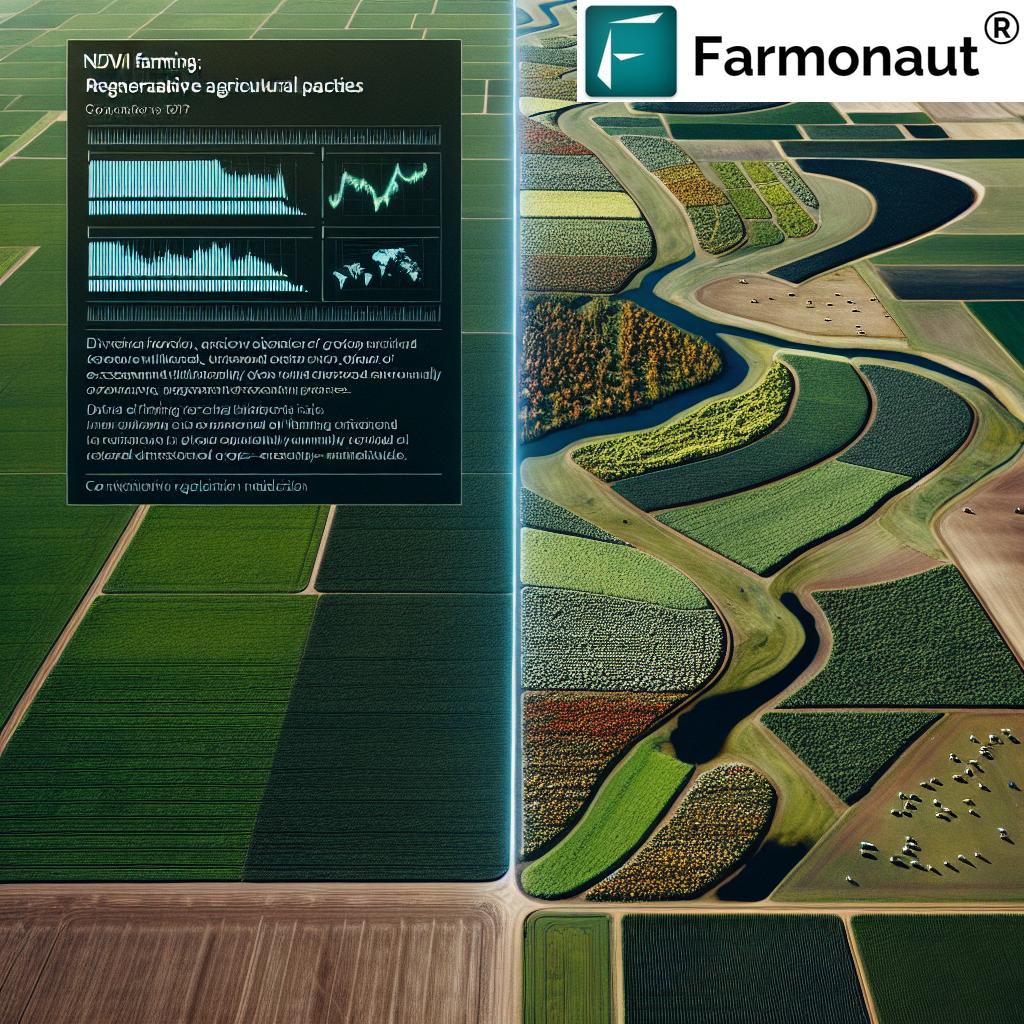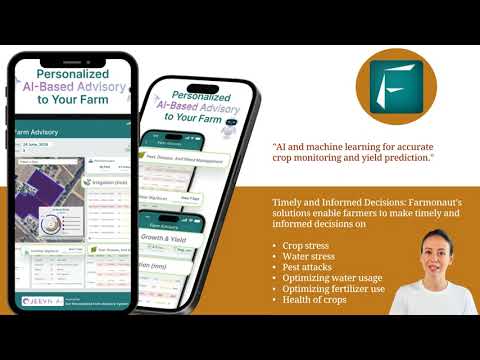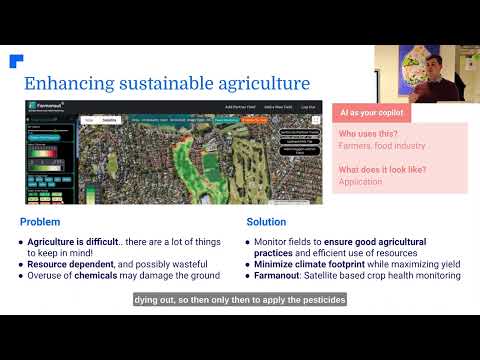Revolutionizing Canadian Agriculture: How Satellite Crop Monitoring and AI are Boosting Soil Health and Farm Productivity in Alberta
“Satellite crop monitoring can increase farm productivity by up to 20% through optimized resource management and early issue detection.”

In the heart of Canada’s prairie provinces, Alberta’s vast farmlands are undergoing a revolutionary transformation. The integration of satellite crop monitoring and AI-powered precision agriculture is reshaping the landscape of modern farming, particularly in enhancing soil health and farm productivity. As we delve into this exciting frontier, we’ll explore how cutting-edge technology is empowering farmers to make data-driven decisions, optimize resource use, and contribute to a more sustainable agricultural future.
The Rise of Precision Farming Technology in Alberta
Alberta’s agricultural sector has long been a cornerstone of the province’s economy. However, facing challenges such as climate change, soil degradation, and the need for increased food production, farmers are turning to innovative solutions. Enter precision farming technology, a game-changer that’s revolutionizing how we approach agriculture in the region.
- Satellite-based crop monitoring systems
- AI and machine learning algorithms for farm management
- Remote sensing technologies for real-time data collection
- Advanced weather forecasting for precise decision-making
These technologies are not just futuristic concepts; they’re becoming integral parts of day-to-day farming operations across Alberta. By leveraging these tools, farmers can gain unprecedented insights into their croplands, enabling them to make informed decisions that boost productivity while promoting environmental stewardship.
Satellite Crop Monitoring: A Bird’s-Eye View of Farm Health
At the forefront of this agricultural revolution is satellite crop monitoring. This technology provides farmers with a comprehensive, real-time view of their fields, offering critical information about crop health, soil moisture levels, and potential issues before they become visible to the naked eye.
Here’s how satellite crop monitoring is transforming Alberta’s farms:
- Early Detection of Crop Stress: Satellites equipped with multispectral sensors can detect changes in plant health long before they’re visible to farmers on the ground. This early warning system allows for timely interventions, potentially saving entire crops from disease or pest infestations.
- Optimized Resource Allocation: By providing detailed maps of crop vigor across fields, satellite data helps farmers apply water, fertilizers, and pesticides precisely where they’re needed most. This targeted approach not only reduces input costs but also minimizes environmental impact.
- Improved Crop Yield Predictions: Advanced algorithms can analyze satellite imagery over time to predict crop yields with increasing accuracy. This information is invaluable for farm planning, market strategizing, and ensuring food security.
One of the key players in bringing this technology to Alberta’s farmers is Farmonaut. Their platform integrates satellite imagery with AI-powered analytics to provide actionable insights directly to farmers’ devices. With Farmonaut’s solutions, even small-scale farmers can access the benefits of precision agriculture, leveling the playing field and promoting sustainable practices across the industry.
AI in Farm Management: The Brain Behind the Operation
Artificial Intelligence (AI) is rapidly becoming the brain behind modern farm management, offering capabilities that were once thought impossible. In Alberta, AI-powered farm management tools are helping farmers make sense of the vast amounts of data collected through satellite monitoring and other sources.
Key applications of AI in Alberta’s agriculture include:
- Predictive Analytics: AI algorithms can forecast weather patterns, pest outbreaks, and optimal planting times with remarkable accuracy.
- Automated Decision Support: AI systems can provide real-time recommendations on irrigation, fertilization, and pest control, tailored to specific crop needs and local conditions.
- Crop Disease Identification: Machine learning models can analyze satellite and drone imagery to identify signs of crop diseases early, allowing for targeted treatment.
Farmonaut’s Jeevn AI Advisory System exemplifies the power of AI in agriculture. This innovative tool delivers personalized farm advice, combining satellite data analysis with expert agricultural knowledge to guide farmers in making optimal decisions for their specific conditions.
Regenerative Agriculture Practices: Nurturing Soil Health
While technology plays a crucial role in modernizing agriculture, the importance of soil health cannot be overstated. Regenerative agriculture practices are gaining traction in Alberta as farmers recognize the long-term benefits of nurturing their soil.
Key regenerative practices being adopted include:
- Cover Cropping: Planting cover crops during off-seasons protects soil from erosion, improves soil structure, and enhances biodiversity.
- No-Till or Reduced Tillage: Minimizing soil disturbance helps maintain soil structure, retain moisture, and promote beneficial microbial activity.
- Crop Rotation: Implementing diverse crop rotations helps break pest cycles, improves nutrient cycling, and enhances overall soil health.
- Integrating Livestock: Holistic grazing management can improve soil fertility and increase carbon sequestration in pastures and croplands.
The synergy between these regenerative practices and precision agriculture technologies is where the true revolution lies. Satellite monitoring and AI analytics can help farmers fine-tune their regenerative approaches, ensuring they’re implemented effectively and yield maximum benefits.
Carbon Sequestration: Agriculture’s Role in Climate Mitigation
“AI-powered precision agriculture tools can reduce water usage by up to 30% while maintaining or improving crop yields.”
Carbon sequestration in agriculture is becoming an increasingly important topic in Alberta. As the world grapples with climate change, farmers are discovering that they can play a significant role in mitigating its effects through sustainable land management practices.
Here’s how Alberta’s farmers are contributing to carbon sequestration:
- Soil Organic Matter Enhancement: By implementing no-till practices and cover cropping, farmers are increasing the organic matter content in their soils, effectively locking away carbon.
- Agroforestry Techniques: Integrating trees and shrubs into agricultural landscapes not only provides habitat for wildlife but also sequesters carbon in both above-ground biomass and root systems.
- Precision Resource Management: Using satellite data and AI to optimize inputs reduces unnecessary emissions associated with over-application of fertilizers and excessive machinery use.
Farmonaut’s platform includes features for carbon footprint tracking, allowing farmers to monitor their progress in reducing emissions and increasing carbon sequestration. This data can be valuable not only for environmental stewardship but also for potential participation in carbon credit markets.
The NDVI Revolution: Precision in Crop Health Analysis
One of the most powerful tools in the satellite crop monitoring arsenal is the Normalized Difference Vegetation Index (NDVI). This index has revolutionized how we assess crop health and vigor from space.
NDVI works by measuring the difference between near-infrared light (which healthy vegetation strongly reflects) and red light (which vegetation absorbs). The resulting index provides a numerical indicator of plant health and density.
Benefits of NDVI for Alberta’s farmers include:
- Early Stress Detection: NDVI can reveal areas of crop stress before they’re visible to the naked eye, allowing for prompt intervention.
- Yield Forecasting: By tracking NDVI over time, farmers can make more accurate predictions about potential yields.
- Variable Rate Applications: NDVI maps enable precise application of inputs like fertilizers, optimizing resource use and reducing environmental impact.
Farmonaut’s platform leverages NDVI and other advanced vegetation indices to provide farmers with detailed, actionable insights about their crops’ health and performance throughout the growing season.

Sustainable Crop Rotation: Balancing Productivity and Conservation
Sustainable crop rotation is a cornerstone of modern agriculture in Alberta. By carefully planning the sequence of crops grown in a field, farmers can break pest cycles, improve soil health, and optimize nutrient use efficiency.
Key benefits of well-planned crop rotations include:
- Improved Soil Structure: Different crop types have varying root systems that can improve soil structure at different depths.
- Enhanced Nutrient Cycling: Alternating between crops with different nutrient needs helps maintain soil fertility and reduce dependency on synthetic fertilizers.
- Increased Biodiversity: Diverse crop rotations support a wider range of beneficial insects and microorganisms, contributing to overall ecosystem health.
- Risk Mitigation: Growing a variety of crops can help buffer against market fluctuations and crop-specific pests or diseases.
Satellite crop monitoring and AI analytics play a crucial role in optimizing crop rotation strategies. By analyzing historical yield data, soil health indicators, and market trends, these technologies can help farmers make informed decisions about which crops to plant and when.
Farmonaut’s API allows for seamless integration of satellite data and analytics into existing farm management systems, enabling more sophisticated crop rotation planning.
Holistic Grazing Management: Integrating Livestock for Soil Health
Holistic grazing management is gaining traction in Alberta as a way to improve soil health, increase carbon sequestration, and enhance biodiversity on both pastures and croplands. This approach involves carefully planned grazing patterns that mimic natural herd movements.
Benefits of holistic grazing include:
- Improved Soil Organic Matter: Grazing animals contribute manure and stimulate plant growth, increasing soil organic matter content.
- Enhanced Water Retention: Better soil structure from holistic grazing practices increases the land’s capacity to absorb and retain water.
- Increased Plant Diversity: Proper grazing management encourages a diverse mix of plant species, improving ecosystem resilience.
- Reduced Reliance on Inputs: By cycling nutrients naturally through grazing, farmers can reduce their dependence on synthetic fertilizers.
Satellite monitoring can assist in holistic grazing management by providing real-time data on pasture conditions, helping farmers make informed decisions about when and where to move their herds for optimal impact.
Precision Agriculture Solutions: Tailoring Practices to Local Conditions
Precision agriculture solutions are all about doing the right thing, in the right place, at the right time. In Alberta’s diverse agricultural landscape, this approach is crucial for maximizing efficiency and sustainability.
Key components of precision agriculture include:
- Variable Rate Technology (VRT): Using GPS and detailed field maps to apply inputs at varying rates across a field, matching application to specific needs.
- Soil Sampling and Mapping: Creating detailed soil maps to understand variability in nutrient levels, pH, and other soil properties across fields.
- Yield Monitoring: Using sensors on harvesting equipment to create detailed yield maps, helping identify areas of high and low productivity within fields.
- Precision Irrigation: Employing soil moisture sensors and weather data to apply water precisely where and when it’s needed most.
Farmonaut’s platform integrates these precision agriculture techniques with satellite data and AI analytics, providing Alberta’s farmers with a comprehensive toolkit for optimizing their operations.
The Future of Farming: Integrating Technology and Sustainability
As we look to the future of agriculture in Alberta, it’s clear that the integration of advanced technologies with sustainable farming practices will play a pivotal role. The challenges of feeding a growing population while mitigating climate change and preserving natural resources demand innovative solutions.
Key trends shaping the future of farming in Alberta include:
- AI-Driven Decision Making: As AI models become more sophisticated, they’ll provide increasingly accurate and personalized recommendations for farm management.
- Internet of Things (IoT) in Agriculture: Networks of sensors throughout farms will provide real-time data on soil conditions, crop health, and equipment performance.
- Blockchain for Traceability: Implementing blockchain technology in the agricultural supply chain will enhance food safety and consumer trust.
- Robotics and Automation: Autonomous vehicles and robotic systems will increasingly handle routine farming tasks, improving efficiency and reducing labor costs.
Farmonaut is at the forefront of this agricultural revolution, continuously innovating to provide farmers with cutting-edge tools for sustainable and productive farming. Their commitment to making precision agriculture accessible to farms of all sizes is helping to democratize these advanced technologies.
Farmonaut’s API Developer Docs provide a gateway for tech-savvy farmers and agricultural software developers to integrate these powerful tools into their own systems and applications.
Comparative Analysis: Traditional vs. Satellite-Powered Farming in Alberta
| Farming Aspect | Traditional Method | Farmonaut Satellite System |
|---|---|---|
| Soil Health Monitoring | Manual soil sampling, time-consuming and limited coverage | Real-time, high-resolution soil health maps covering entire fields |
| Crop Rotation Planning | Based on historical knowledge and general guidelines | Data-driven decisions using AI analysis of crop performance and soil health trends |
| Water Management | Scheduled irrigation based on general crop needs | Precision irrigation guided by satellite-derived soil moisture maps and weather forecasts |
| Pest Detection | Regular field scouting, reactive approach | Early detection through spectral analysis, enabling proactive management |
| Yield Prediction | Estimates based on past yields and visual assessment | Advanced modeling using multi-year satellite data, weather patterns, and AI algorithms |
Empowering Alberta’s Farmers with Farmonaut
Farmonaut’s suite of tools is designed to empower Alberta’s farmers with the insights they need to make informed decisions and optimize their operations. Whether you’re managing a small family farm or overseeing large-scale agricultural operations, Farmonaut’s platform offers scalable solutions to meet your needs.
Key features of Farmonaut’s platform include:
- Real-time Crop Monitoring: Access up-to-date satellite imagery and health indices for your fields.
- AI-Powered Recommendations: Receive personalized advice on crop management, pest control, and resource allocation.
- Weather Integration: Make informed decisions with accurate, field-specific weather forecasts.
- Historical Data Analysis: Track your farm’s performance over time and identify long-term trends.
- Mobile Accessibility: Access all these features on-the-go with Farmonaut’s mobile apps.
By leveraging these tools, Alberta’s farmers can stay at the forefront of agricultural innovation, improving their productivity while contributing to a more sustainable future for Canadian agriculture.
Conclusion: A New Era for Alberta’s Agriculture
The integration of satellite crop monitoring, AI-powered analytics, and sustainable farming practices is ushering in a new era for Alberta’s agricultural sector. By embracing these technologies and approaches, farmers are not only boosting their productivity and profitability but also contributing to the long-term health of their land and the environment.
As we continue to face challenges such as climate change, soil degradation, and the need for increased food production, the tools and practices discussed in this article will become increasingly crucial. Farmonaut’s commitment to making these advanced technologies accessible to farmers of all scales is playing a vital role in democratizing precision agriculture and promoting sustainable farming practices across Alberta and beyond.
The future of farming in Alberta is bright, powered by satellites, guided by AI, and grounded in sustainable practices. As we move forward, the collaboration between innovative technology providers like Farmonaut and the skilled, adaptable farmers of Alberta will be key to ensuring a prosperous and sustainable agricultural future for generations to come.
FAQs
- How does satellite crop monitoring work?
Satellite crop monitoring uses images captured by satellites to assess crop health, soil moisture, and other key agricultural indicators. These images are analyzed using various spectral bands and indices like NDVI to provide insights into crop conditions. - Can small-scale farmers benefit from precision agriculture technologies?
Yes, absolutely! Platforms like Farmonaut are designed to be accessible and scalable, allowing farmers of all sizes to benefit from precision agriculture technologies. - How does AI contribute to farm management?
AI analyzes vast amounts of data from satellites, weather stations, and on-farm sensors to provide personalized recommendations on planting, irrigation, fertilization, and pest control. - What is regenerative agriculture, and why is it important?
Regenerative agriculture involves practices that improve soil health, increase biodiversity, and sequester carbon. It’s important for long-term sustainability and resilience of agricultural systems. - How can farmers get started with satellite crop monitoring?
Farmers can get started by signing up for a service like Farmonaut, which provides user-friendly access to satellite data and analytics. Many providers offer free trials or demos to help farmers understand the technology.






